Thuja western "Golden Smaragd": description and cultivation
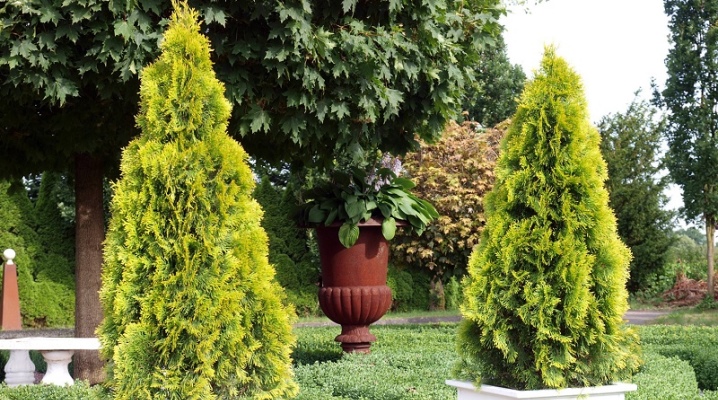
The owners of summer cottages always want their territory to look beautiful and dignified. Therefore, for landscaping and giving a spectacular look to the territory, thuja are often planted. There are quite a few varieties of such plants, and each of them has its own unique characteristics, but today we will focus on only one. It is called the western thuja "Golden Smaragd".
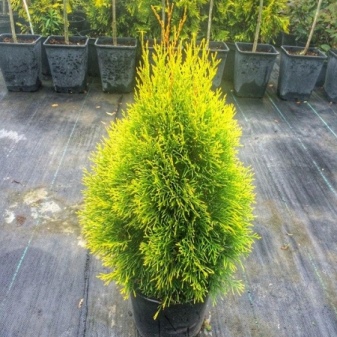
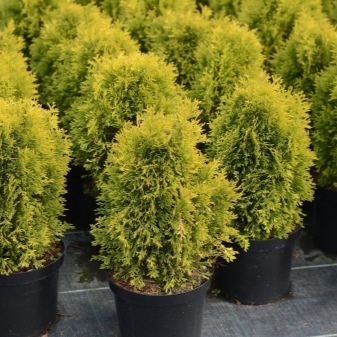
Description of the variety
Golden Smaragd, which can be literally translated as Golden Emerald, is a variety first created in Poland by breeder Edward Kubik. The size of the planted tree is small at first, and it grows rather slowly - a maximum of 20 cm per year. By the age of ten, the thuja reaches a mark of 2.5 meters and subsequently also continues to increase, growing up to 5 meters or more.
The needles of the plant are green-golden, which gave rise to its name, they remain so all year round. If you rub the "foliage" with your fingers, you can feel the usual cool aroma of pine needles. In the spring, small cones form on the tree, in the fall, the thuja drops them. The crown of the "Golden Smaragd" is conical in shape, tapers upwards. In width it can reach almost 2 meters, but generally the indicators fluctuate between 1 and 1.8 meters.
The tree lives for a long time - up to 100 years, but in order to reach a similar mark, it requires good care and attention.
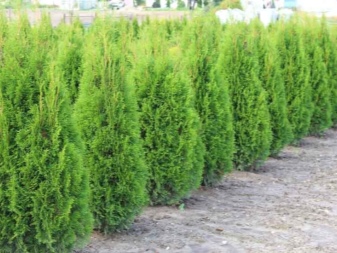

Landing features
Thuja is planted, as a rule, in autumn or spring. Spring planting is preferable, because over the summer the plant will get stronger, acclimatize and completely settle down on the site. If time has already been lost, you can plant thuja in the fall, but you cannot delay it, you must try to do it as early as possible. Only in this way will the plant be able to develop at least a little before winter in order to survive it. By the way, if you bought a thuja in a pot, then you can plant it in early June.
The first preparatory stage for landing is the selection of a site. Unlike many other plants, Golden Smaragd does not suffer too much from sunburn, so you can plant it in an open area.
Shaded and shaded areas are a bad idea, the tree will grow slowly, and you won't have to wait for the attractiveness of the crown. In addition, it is better to choose a site that is not too ventilated.
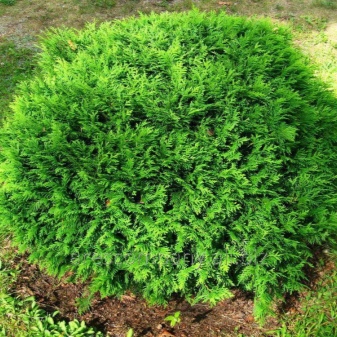
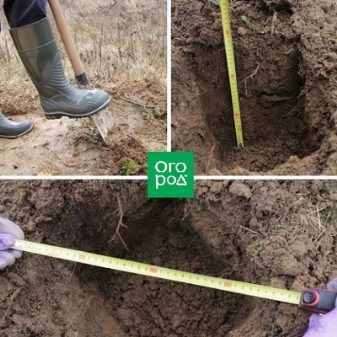
The soil in which thuja is to grow should be loose and light. The best option is a combination of peat, sandstone and black soil. Make sure that no ground water flows close to the surface. If there are no other options, you will have to make a thorough drainage of expanded clay, broken pieces of brick, earthenware, pebbles. Having finished all the necessary preparations, you can proceed directly to planting the plant. After evaluating the size of the earthen coma, a hole is dug at the landing site, at least 2 times the size of the coma. The depth of the pit is about a meter, at the bottom there must be a 15-centimeter drainage layer. When planting, make sure that the root collar of the plant is not buried in the ground. In addition, the bottom of the "foliage" should not be located directly on the ground.
Then the lump itself is well moistened and left to soak for about an hour. After the lapse of time, half of the pit is covered with soil and installed strictly in the middle of the tree. The remaining earth is added to the dug thuja, watered, and then mulched. For this, it would be good to use sawdust, humus, peat.Such protection will help the plant to take root faster and save it from frost, overheating, and pests.
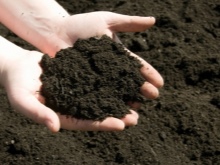
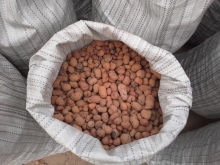
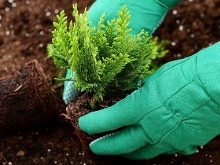
Correct care
Caring for Golden Smaragd is not too difficult and burdensome, but care should be regular. The first condition for harmonious development is, of course, watering. Thuja of this variety requires stable moisture, so it will have to be watered once a week. If you do not adhere to this rule, the plant will begin to dry out and lose its attractiveness. Thuja is very fond of western thuja and sprinkling, after which its needles acquire a beautiful shine, and dust and small pests are washed off with water. After watering, it is advisable to loosen the soil near the plant. Thus, you provide oxygen access to the tree's root system. You need to loosen it not too deeply - no more than 10 cm, since the roots are located close to the surface of the earth.
Pruning is another rule that a gardener should take note of. There are several types of pruning, but the most demanded of them is sanitary. It is produced at any time except winter. A similar procedure is designed to rid the tree of dry, diseased, depleted branches. After her, the thuja has new powers, which she will no longer spend on outdated specimens.
When performing the procedure, you need to remember that all branches are cut with a sharp, disinfected pruner; breaking off with your hands is strictly prohibited.
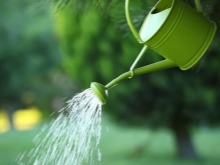


In addition, there is also a deep pruning, which allows you to shape the crown. The features of such pruning are due to the purpose for which the plant is planted. For example, if you grow thuja in the form of a small hedge, you will need to cut the tops from time to time. Also, do not forget that the distance between individual bushes should be at least half a meter. A closer neighborhood will lead to plexus of roots, thickening, and the culture will begin to wither from lack of oxygen and pests.
Thuja will need fertilization several times a year. For this purpose, you should purchase complex fertilizing for conifers. The first feeding is carried out in April, then in May, and the last one at the very end of summer. In the autumn period, fertilization is by no means possible, since even the highest quality fertilizer can provoke the death of the root system from freezing. You also need to take into account that very young trees of the first year of life are fed with fertilizers, the concentration of which is half the recommended one.
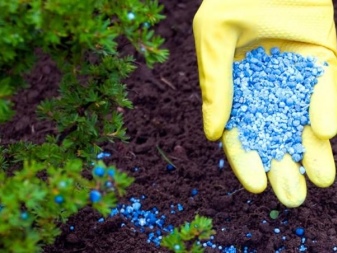

Diseases and pests
With good and conscientious care, the western thuja is extremely rarely affected by diseases. But this still happens, so you should be prepared for anything. Let's look at the main diseases of thuja, as well as methods of dealing with them.
- Fungal ailments. Fungi that provoke late blight and various types of rot have long been a misfortune for gardeners. You can determine the disease by the characteristic smell of rot from the ground, yellowing and wilting of shoots, the appearance of mold. As soon as the "diagnosis" is made, all diseased shoots are immediately cut off and burned away from the site. The remaining parts of the plant are treated with strong fungicides. In addition, remember that if the disease is recognized late, and the fungus has already covered the roots, it must be completely dug out, replacing the soil in which it grew.
- Thuya false shield Are tiny, malicious bugs that multiply at an enviable speed. Yellowish sores will tell about their appearance, which will become more and more every day. Treatment must be quick, otherwise the plant will soon die. Insecticides such as "Karbofos" are used to combat false shield. You can also purchase special duct tape that will prevent insects from moving along the trunk.
- Rust. This disease, like shute, mainly affects only young trees. Plants wither noticeably, dry up, the crown darkens, and the needles fall off. The first thing to do is to remove all branches affected by the disease.Then the plant is sprayed with the preparation "Hom"; it can be replaced with a Bordeaux mixture. If the treatment is done, but there are no results, try Fundazol. Dilute 20 g of the product in a bucket of water, then water the ground near the thuja, spraying is not required.
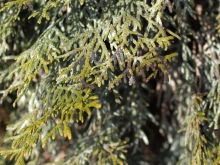
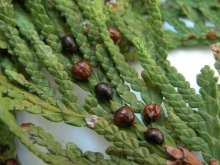
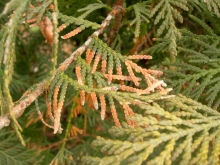
Remember that most diseases are caused by the gardener. Various errors can lead to them:
- improper watering;
- lack or excess of fertilizers;
- violation of the distance between trees;
- wrong choice of site or soil.
To protect thuja, always take care of them responsibly, and at the first signs of disease, be sure to carry out preventive spraying for other plants on the site, especially conifers.
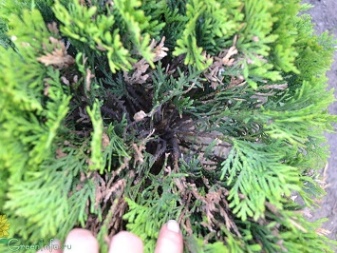

Application in landscape design
"Golden Smaragd" is a plant that feels great both in a clean area and in a polluted urban area, which is why it is often used for landscaping park areas. Thuja western is good because it looks majestic both alone and in the company of other plants. Roses and dahlias will look elegant next to her, as well as a carpet of small petunias. An interesting idea would be to create a small hedge. As already mentioned, the distance between the thuja should be at least half a meter if you want a denser fence. A distance of a meter will allow you to create a sparse hedge.
Plants of other conifers look great next to the thuja, but they should be compact. For example, it can be decorative pines and Christmas trees, beautifully decorated juniper bushes. Thuja looks very interesting in the design of a boxwood or hydrangea. More demanding gardeners can create whole sculptures from thuja on the site, but for this you should independently learn professional sculptural pruning or regularly invite a specialist for correction.
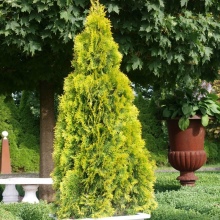
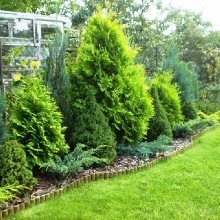
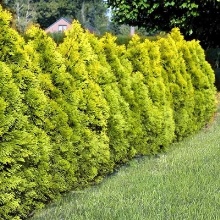
In the next video you will find interesting facts about the Golden Smaragd variety.



































































The comment was sent successfully.